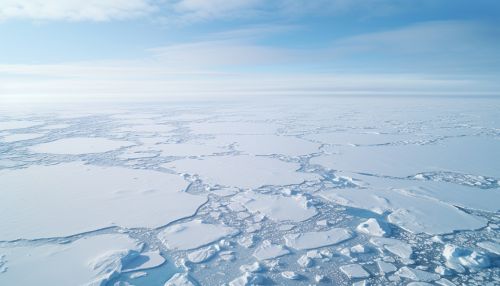Ice shelf
Introduction
An ice shelf is a large, floating extension of an ice sheet, typically several hundred meters thick. Ice shelves are found in Antarctica, Greenland, Canada, and the Russian Arctic, extending into the ocean from the coast but remaining attached to the land. They are formed by the process of glacier flow and the accumulation of snow.
Formation
Ice shelves are formed primarily by snow falling on the ice sheet. Over time, the snow compacts under its own weight and turns into ice. This process is known as firnification. The ice gradually flows towards the coast under the force of gravity. When it reaches the coast, it continues to flow out over the ocean, forming an ice shelf.


Structure
Ice shelves are composed of firn, ice, and often contain layers of marine ice at their base. The upper surface is typically smooth and flat, while the underside is irregular and can be deeply eroded by the ocean. The thickness of an ice shelf can vary greatly, from a few hundred meters to over a kilometer.
Dynamics
The dynamics of ice shelves are complex and involve a balance between the forces of gravity, buoyancy, and the viscosity of the ice. Ice shelves are constantly moving, flowing outwards from the coast at a rate of several hundred meters per year. They also lose mass through calving of icebergs and melting at their base.
Importance
Ice shelves play a crucial role in regulating the flow of glaciers and ice sheets into the ocean. They act as a buttress, slowing down the flow of ice from the interior. If an ice shelf collapses, the glaciers feeding into it can accelerate, leading to increased sea level rise.
Ice Shelf Instability
Ice shelves are vulnerable to climate change and ocean warming. Warming air temperatures can increase the amount of surface melting, while warming ocean waters can increase melting at the base. This can lead to the formation of melt ponds and iceberg calving, which can destabilize the ice shelf.
Notable Ice Shelves
There are many notable ice shelves around the world, including the Ross Ice Shelf, the Ronne Ice Shelf, and the Larsen Ice Shelf. These ice shelves are important for scientific research and are closely monitored for signs of change.
